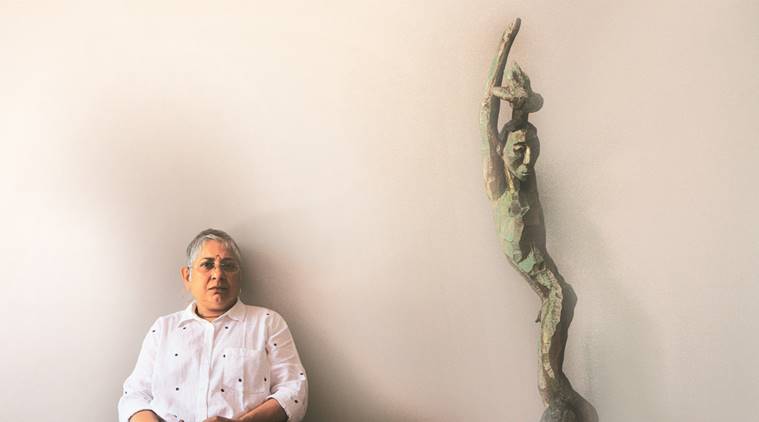‘We need to be more inclusive’: Anita Dube
Artist Anita Dube, curator of the fourth edition of the Kochi-Muziris Biennale, talks about questioning hierarchies and breaking stereotypes

Anita Dube Neeraj Priyadarshi
In your curatorial note for the Kochi-Muziris Biennale you share this: the desire for liberation and comradeship where the possibilities for a non-alienated life could spill into a ‘politics of friendship’. Can you elaborate.
In recent times, media has taken over our lives and we are all constantly looking into our screens. We are communicating a lot but actually not communicating. This is one of the reasons why changes in society are happening so rapidly. I feel one of the reasons for the rise of the right-wing is that they have been working at the grassroots. They have a live community, apart from mobilising through technology. The liberal resistance has not been able to mobilise, except in small numbers. The world is becoming alienated. This is what I want to work against. It is about identifying the core problems. It is important for me to think that the Biennale is in this moment, in 2018, and what are the things that I would like to address at this moment in history. The second important question is, who is my audience? It is not just the one percent that is travelling and looking at art the world over. This is a public event. There is a curious audience that has a level of literacy where they want to look at culture as a window. Six lakh people attended the last Biennale. The aim is not to put out a spectacular show. I am not looking at the star system.
Is there a tendency to look at the stars?
That’s how it has been. The capital circulates within that one percent. It is about time we talk differently, or else things will slide further. I know it is a 108-day event, I am trying to set up small models that might be taken up elsewhere. I think the future is micro, in intense well-articulated micro events, and building a strong network of these. I am looking at practices in the margins, from the obvious political margins, Dalit artists, queer artists, to even contemporary women artists, whose works I admire but haven’t perhaps been in the limelight as much. The Biennale will be like a symphony. It will be open to all kinds of mediums. People can make their choices. We need to open up practices, be inclusive.
I was reading that during your travels for the Biennale you focussed on the South of the equator.
There are artists from the US, but yes, there a strong representation from Africa, Latin American artists. Unfortunately, I could not travel to Brazil and Argentina. There is a lot of Indian diaspora — I think that is important because they leave the place but carry the nostalgia. They are harbingers of this kind of fusion, and have potential to forge languages that are futuristic. We have artists such as Chitra Ganesh and Shirin Neshat.
Your own art is very political. Will the Biennale also be dominated by political works?
Art is about thinking of different things and in the Biennale there will be a strong sense of thinking artists. Politics is not something that I am looking at directly. Sloganeering politics can be counter-productive, you can become totally alienated and be stereotyped. Look at how JNU and Marxism have become bad words. It’s a wonderful university; Marxism is a theory, philosophy. The regressive forces can just brand you and kill your voice. In the Biennale, I am not doing politics like that. I am consciously refraining from making it one that carries the strings of being a political biennale. I want to wean people off from this logic of stereotyping.
Do you think you have additional responsibility as the first woman curator of the Biennale?
It is tremendous responsibility. This is also perhaps the first time when there will be more women than men. I don’t think that has happened anywhere. Only two artists will be repeated from the earlier editions — William Kendrick and KP Krishnakumar. So I am also working with artists who may not have been considered uptil now.
What is your curatorial vision?
I am imagining the Biennale in two parts. The exhibition is just one aspect. The other aspect is a pavilion, where things will happen in the evening, including programmes and performances. During the day it will be a conversation space. Anybody is welcome to share what they want, there will be lectures and slides. Everybody is a curator. I want to give up my authority. It will be a major knowledge laboratory. It is the biggest classroom possible. It will open the audience and younger artists to a much bigger vision than just mine.
Did the recent floods in Kerala derail things. Also, did it affect the line-up?
When it happened, there was a dilemma, should we go ahead or postpone it. Many projects were on the verge of completion. Some artists decided to respond to the floods more directly. We are talking to a music band, Oorali, to travel through coastal Kerala with their bus and thank the fishermen who helped rescue people during the floods.






















 KP Krishnakumar’s Boy Listening
KP Krishnakumar’s Boy Listening
No hay comentarios:
Publicar un comentario